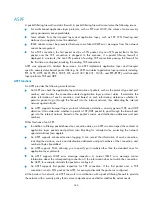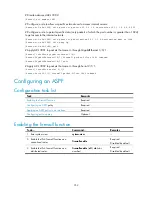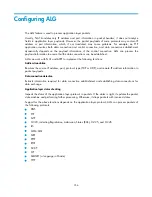
356
Configuring ALG
The ALG feature is used to process application layer packets.
Usually, NAT translates only IP address and port information in packet headers; it does not analyze
fields in application layer payloads. However, the packet payloads of some protocols may contain IP
address or port information, which, if not translated, may cause problems. For example, an FTP
application involves both data connection and control connection, and data connection establishment
dynamically depends on the payload information of the control connection. ALG can process the
payload information to ensure that the data connections can be established.
ALG can work with NAT and ASPF to implement the following functions:
Address translation
Resolves the source IP address, port, protocol type (TCP or UDP), and remote IP address information in
packet payloads.
Data connection detection
Extracts information required for data connection establishment and establishing data connections for
data exchange.
Application layer status checking
Inspects the status of the application layer protocol in packets. If the status is right, it updates the packet
state machine and performing further processing. Otherwise, it drops packets with incorrect states.
Support for the above functions depends on the application layer protocol. ALG can process packets of
the following protocols:
•
DNS
•
FTP
•
GTP
•
H.323, including Registration, Admission, Status (RAS), H.225, and H.245
•
ILS
•
MSN/QQ
•
NBT
•
PPTP
•
RTSP
•
SCCP
•
SIP
•
SQLNET (a language in Oracle)
•
TFTP
















































